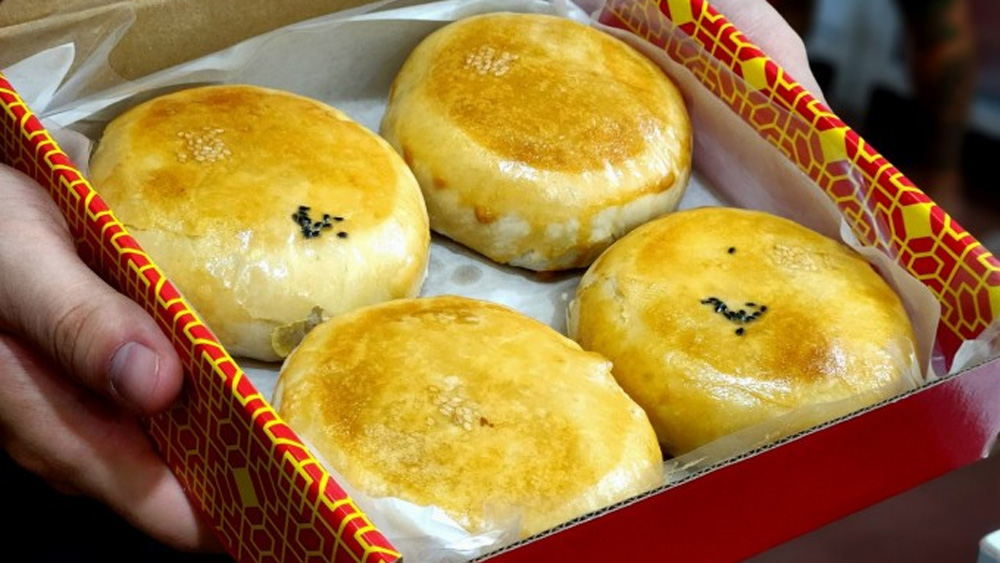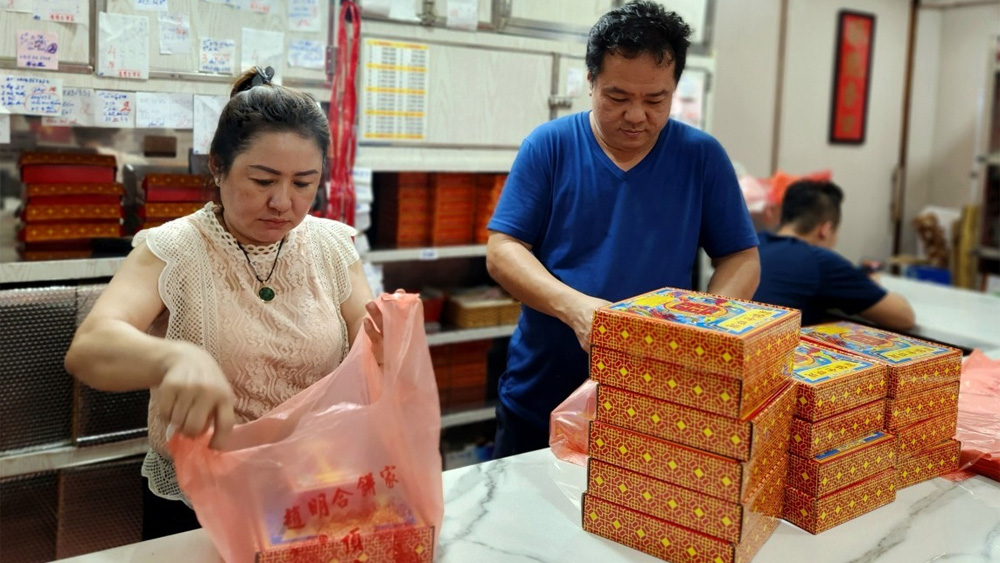75 years of handmade Teochew pia cakes in Saigon
To mark Mid-Autumn Festival, the people with Teochew heritage from China in Ho Chi Minh City often exchange boxes of crispy-shelled pia, filled with green beans, taro, and salted eggs.
 |
|
A box of four Teochew handmade pia cakes at Trieu Minh Hiep Bakery in HCMC's District 6. |
Trieu An, the owner of Trieu Minh Hiep pia shop in District 6, notes the rarity of handmade pia cakes in the city. These cakes hold an enduring place in Teochew culture, gracing weddings and Lunar New Year holidays for generations. The name pia itself is derived from the Teochew dialect, meaning cake.
In contrast to the popular Cantonese-style mooncakes, pia cakes are mainly reserved for Mid-Autumn Festival celebrations among Teochew people. Within each box, diners will find four pia cakes, each adorned with a golden crust.
Pia first made their way to southern Vietnam in the 17th century, brought by the Minh Huong people, a group of Chinese nationals who took refuge in southern Vietnam. Today, the Teochew community in Ho Chi Minh City still preserves this cherished treat.
Trieu An's family bakery, now in its third generation, executes each step of the process by hand. According to An, the cakes have a short shelf life of 10 days and are ideally enjoyed fresh out of the oven.
In the 1930s, Trieu Minh Hiep, An's grandfather, moved to Vietnam and settled in Cho Lon neighborhood, which is today Districts 5, 6, and 11 of Ho Chi Minh City. At the beginning, the Trieu family's business was a modest basket of pia sold at local markets.
It was not until 1948 that Hiep established a small bakery on Binh Tay Street in District 6. The bakery has remained in the same location for 75 years, adhering to the same traditional methods employed since day one.
The pia making process has two phases: making the crust and preparing the filling. The filling comprises green beans and fresh taro, steamed and blended with sugar on the stove for around two hours until it forms a soft mass. These filling blocks are then adorned with salted egg.
An said that only fresh salted eggs are used, resulting in a softer and spongier texture compared to those containing preservatives. While the filling cools, the dough for the crust is prepared. After a 15-minute resting period, the dough is rolled out and hand-shaped into simple, flat round forms without the patterns seen on traditional molded mooncakes.
The absence of flour in the filling lends the cake its soft, delicate texture. The use of molds, as An explains, would cause the cake to disintegrate, intermixing the crust with the filling. Following shaping, the cakes spend about 30-45 minutes in the oven. Upon emerging, they are coated with lard, rendering the crust a golden hue.
The contact between the hot cake surface and the fat produces a distinct, slightly burnt aroma that greets visitors as they enter the shop. What sets An's bakery apart is that the cakes are delivered while they are still warm.
"Pia can be enjoyed both warm or cold, but there's nowhere else that delivers them as hot as we do. When our cakes arrive, they carry the aroma of freshly baked goods, and even the boxes emanate warmth. This experience allows our customers to savor the freshness and handmade quality that sets our cakes apart from the mass-produced ones, even when they come in more elaborate packaging," An said.
Despite the trend of meticulously designed boxes among mooncake brands, Trieu Minh Hiep Bakery has adhered to simple paper boxes for years. These boxes, hand-folded and printed in vibrant color, have been a tradition. However, due to the closure of the box factory, the shop now uses printed paper boxes with less intricate designs. An explains that the paper boxes absorb moisture and maintain the cakes' warmth, preventing them from becoming soggy. Creating a batch of 30-40 cakes requires approximately three hours.
On an average day, the shop sells around 30-40 boxes, each containing four cakes priced between VND220,000 and VND280,000 (US$8-11), depending on the variety.
In the month leading to Mid-Autumn Festival, which peaks on September 29 this year, customer traffic trebles or even quadruples, with the shop selling over 100 boxes daily. Customers often place advance orders, ensuring timely access to fresh cakes.
 |
|
Trieu An and his wife prepare the order for the guest. |
"On many occasions, walk-in customers must either wait for freshly baked cakes or return the following day, as small-scale production often leads to daily sell-outs. Even with our bakers working tirelessly, we still cannot meet the demand," An said.
Minh Hieu, a resident of District 5 that borders District 6, recounts how he often stops by the bakery after work to purchase one or two boxes without prior reservation. When he is asked to return the next morning as the cakes are sold out, Hieu accepts this as common.
"When I buy here without pre-ordering, eight times out of ten, either the cakes are already sold out, or I need to wait for the next batch to be baked."
Hieu particularly enjoys them during Mid-Autumn Festival because they have just the right amount of sweetness, a crispy crust, and are not overly greasy.
The shop owner mentioned that the customer base has steadily grown, extending beyond the Teochew community to people from various places. Nevertheless, there are no intentions to open additional branches.
The primary focus is on passing it down to family members because they are determined to preserve the business, which their ancestors built over the years, and they want to ensure it remains in trusted hands to uphold its reputation.
Source: VnExpress
 Bắc giang
Bắc giang















Reader's comments (0)